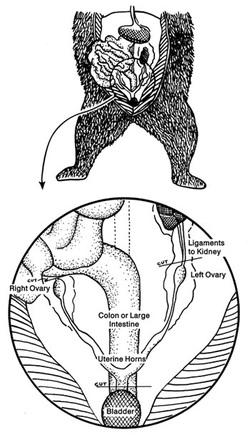Animal common name: Giant Panda
Scientific name: Ailuropoda Melanoleuca
Rachel Terrazas
Zoology, P.4
 |
| http://media.boingboing.net/wp-content/uploads/2011/09/RTR2RVTW.jpg |
The scientific class for giant pandas is ailuropoda melanoleuca. The average size of the adults are four to five feet. They typically weigh about 300 pounds.
Wild pandas live only in remote, mountainous regions in central China. These forests are cool and wet. Pandas prefer it like this. Giant pandas however, have predators such as leopards, jackals, and yellow-throated marten. In the wild, a panda lives off of bamboo. If they are in a zoo, they consume sugar cane, apples, bamboo, carrots, sweet potatoes, and rice gruel. Their endangered status happens to be endangered.
 |
| http://gianpanda.weebly.com/uploads/1/7/3/7/17374649/229985243.gif |
The function of the respiratory system in the giant panda is to allow it to breathe correctly. Breathing helps pandas get rid of toxic waste such as carbon dioxide. Some of the main organs are the lungs, trachea, bronchi and the diaphragm. Pandas breathe with the help of their diaphragm muscles. The air is in taken through the mouth and then passed through the narrow bronchiole til it then hits the alveoli. The oxygen in the gas is absorbed by the red blood cell. It is delivered to other cells in the body that is in need of oxygen. Then carbon dioxide is then breathed out to clear the body from from any toxins.
 |
| http://gianpanda.weebly.com/organism-system-organs-cells.html |
The nervous system creates the movement of the body in the Panda. It delivers signals to the brain. This system contains two major parts, the Central Nervous System (CNS) and the Peripheral Nervous System (PNS). The Central Nervous system includes the brain and the spinal cord. The Peripheral Nervous system is made up of long nerve fibers that connects the CNS everywhere in the pandas body. It controls the muscles and joints sending information to the brain. The CNS receives information from the skin, muscle and joints. This system function involves the spinal cord and the brain. The spinal cord receives signals from the senses of the Panda. The CNS then uses the information from the senses to help the Panda react, remember, think, and act.
 |
| http://gianpanda.weebly.com/organism-system-organs-cells.html |
The skeletal system contains the tissues such as tendons, ligaments and cartilage that connect them. The panda's skull protects the features of the pandas face. The skeletal system has an allowance for muscles to attach so that the body is able to move. Tendons are tough bands that holds the muscles to the bones. Bones has a structure that is hard on the outside. The inside layer is a spongy, honeycomb-like that is flexible. The inside consist of the bone marrow where new cells are constantly being made for the panda's blood. One interesting fact about their tissues is that The Panda has a special “thumb” that is an enlarged wrist bones, which is called the radial sesamoid. The wrist bone is a comparison to the human thumb. It allows the Panda to hold their bamboo with their forepaw and eat with great speed.
 |
| http://gianpanda.weebly.com/organism-system-organs-cells.html |
Panda's mating season is during March and May. The main cells in the reproductive stage are the sperm and the ova. Multiple sperms can go into the females and then makes it way to the egg (ova) cell. However, the ova is bigger in size to that of the sperm and is not capable of movement. Fortunately only one sperm cell reaches to the ova cell of a panda. It will take weeks for the cells to develop inside the womb.
-





No comments:
Post a Comment